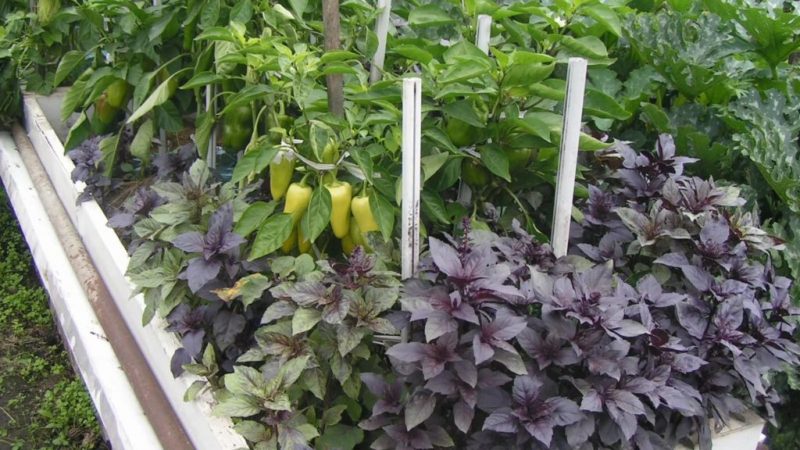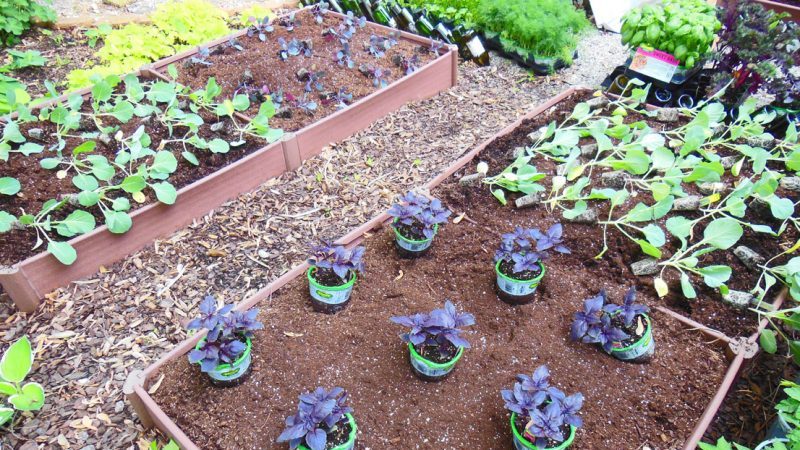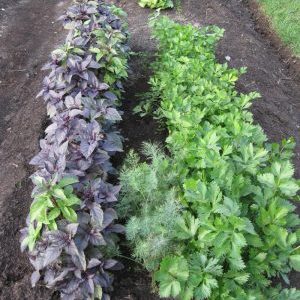Plant compatibility: what to plant next to basil and why it is important
Basil is an annual heat-loving plant native to Asia, a favorite spice of many. Suitable for outdoor cultivation and at home - for example, in pots. It coexists amicably with many crops, protecting them from pests and diseases.
What plants are planted next to it, as well as what are the features of growing spices - read our article.
The content of the article
Crop rotation rules

There are about seventy varieties of early, middle and late ripening basil. They differ in taste, most of them used for salads and as a condiment.
To obtain a high yield for the spice, it is necessary to create conditions close to its usual growing conditions.
Important! Basil is not recommended to be planted in the same place every year, as this increases the risk of fusarium. Landing in the same place is possible in a few years.
In regions with a warm climate, the plant is planted immediately in open ground. In colder regions, it is grown in greenhouses or in seedlings with further transplantation in open ground.
Compliance with the rules of planting and crop rotation of the crop greatly facilitates its care and increases the likelihood of a good harvest.
What plants are best to plant
For the basil, it is not necessary to allocate a separate bed, it is permissible to plant it in beds with other crops, but on the south side.
Important! Low and medium-sized varieties cannot be planted together with tall plants, which will shade a light-loving culture.
It is recommended to plant the spice next to plants that are abundantly fertilized with minerals, as well as with crops that have a shallow, but developed root system.
Neighborhood-friendly plants

The best garden neighbors for scented grass are:
- Pepper. Its trunks will not block sunlight, which is important for the good growth of the basil. It is necessary to plant these crops at a distance of at least 15 cm.
- Carrot. Its developed root system provides moisture to the roots of neighboring plants. You need to sow fragrant grass in rows along the carrot bed, observing an indent of about 20 cm.
- Cabbage and basil consume different trace elements from the soil, so their proximity is favorable. It is recommended to plant 2-3 seedlings between heads of cabbage.
- Legumes... They tend to attract moisture from the soil, which is important for the quality growth of spices. Crops should grow at a distance of at least 20 cm.
- Salad. Its developed root system drains the soil, which enhances the growth of the basil. When planting, it must be borne in mind that the lettuce grows strongly, so it is necessary to plant crops at a distance of at least 30 cm.
- Onion does not take a lot of moisture from the soil, which has a positive effect on the taste of the spice. You can plant these crops in a checkerboard pattern.
- Corn. Needs fertile soil, so this neighborhood is beneficial. It tends to grow strongly, so it is necessary to sow spice at a distance of at least 25-30 cm.
- Zucchini. The neighborhood is favorable, since crops take various trace elements from the soil, but you should not plant them close - keep a distance of at least 30 cm.
- Celery... Its root system is able to attract additional moisture into the soil, which basil needs. It is necessary to sow these crops in parallel rows, keeping a distance of at least 20 cm.
Planting basil to repel insects from other plants
The spice has a specific smell that pests do not like. Therefore, the plant has established itself as an effective remedy for combating such insects:
- aphid;
- spider mite;
- greenhouse whitefly;
- thrips;
- whitefly;
- carrot aphid;
- flies;
- moth;
- bean moth;
- bean weevil;
- chickpea fly.
Planting to protect against disease
Basil is able to protect neighboring crops from such diseases:
- alternaria;
- fusarium;
- black, gray and white rot;
- anthracnose;
- powdery mildew;
- dropsy;
- spotting;
- viral mosaic.
Compatible with tomatoes in the garden and in the greenhouse
Basil is the best neighbor for tomato in the garden and in the greenhouse... The spice protects tomatoes from the Colorado potato beetle, powdery mildew, hornworm, and also improves the taste of the tomato. Both crops need abundant watering and frequent loosening of the soil.
Sow fragrant grass between the trunks of tomatoes, keeping a distance of 15-20 cm. When growing basil with tomatoes together in a greenhouse, avoid darkening the spice. To do this, the tomatoes are tied up and their lower branches are removed.
With cucumbers
Neighborhood with them is also favorable. Basil protects them from powdery mildew and whitefly, and cucumber prevents soil acidification and protects the neighbor from sunlight, which favorably affects the growth of the latter. Both crops need intensive soil moisture, which also makes their neighborhood mutually beneficial.
Important! Basil must be sown between cucumbers, keeping a distance of 10-15 cm.
Bad neighborhood for a basilica

It is not recommended to plant the spice together with other members of the Lamb family. They have common pests, they take the same minerals from the soil - all this leads to a low yield. It is necessary to plant Yasnotkovye on opposite sides of the site, at least 1-2 beds from each other.
Worst neighbors:
- Marjoram. These cultures are representatives of the same family, need the same trace elements, and are prone to the same diseases. Both plants have roots of equal length, which prevents them from absorbing moisture from the soil - this negatively affects their growth, flowering and taste. Basil and marjoram should grow at a distance of at least 3-4 m.
- Dill. This plant is considered unpretentious, but the dill fly and aphids, which like to spoil the dill, easily switch to basil. Moreover, the growth of the crops together makes them taste bitter. They must be planted at a distance of at least 5 m.
- Ruta. It negatively affects the growth of basil, taking all the nutrients from the soil and gradually displacing it from the garden. It is necessary to sow rue and basil at a distance of 5-7 m.
Best and worst predecessors
Best of all, the spice will grow in place of crops, for the development of which the soil was generously fertilized with minerals:
- legumes;

- zucchini;
- Strawberry;
- cucumbers;
- nightshade (potatoes, tomato, eggplant).
What to plant after basil
It is best to grow after it:
- garlic;
- onion;
- zucchini;
- parsley;
- pumpkin;
- squash;
- potatoes.
Conclusion
Now you know what you can plant next to basil in the country, what is its compatibility with other plants and what it combines better with.
Basil is unpretentious and gets along well with many garden plants. With the right approach, growing it together with other crops will increase the yield and improve the taste of the spice. Thanks to its special aroma, basil protects its neighbors from many diseases and pests.